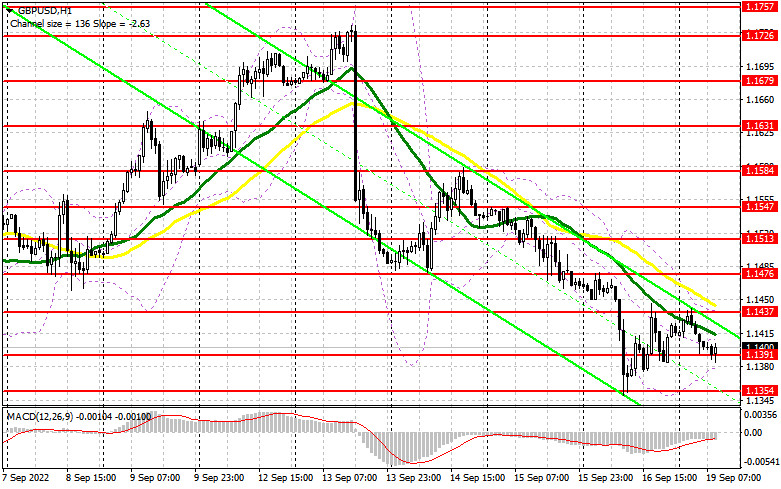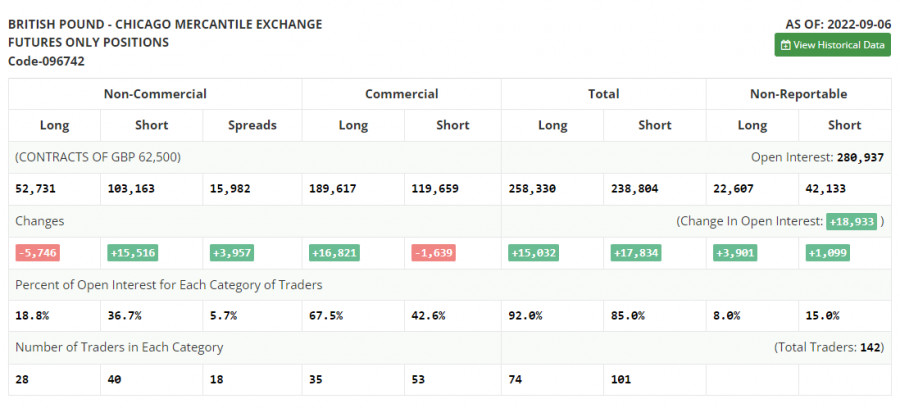
On Friday, a single entry signal was made. Let's take a look at the M5 chart to get a picture of what happened. In my previous morning review, I focused on 1.1358 and considered entering the market at this level. After a steep fall in the first half of the day, GBP tested the support level of 1.1358. A false breakout through that mark produced a buy signal and a correction of over 80 pips to the upside occurred.

When to go long on GBP/USD:
Despite disappointing US macro data and a correction of GBP to the upside on Friday, pressure on the pair increased during the Asian session today. There is still a strong bearish bias ahead of the FOMC meeting. Investors expect a 1.0% rate hike from the Federal Reserve. If this happens, a sell-off of the pound may follow. Today, the macroeconomic calendar contains no reports in the United Kingdom. It would be wiser to go long around the support level of 1.1391 after a false breakout, with the target at the resistance level of 1.1437. The bearish moving averages pass slightly above resistance. A buy signal with the target at 1.1476 will be generated after the price breaks and tests the mark of 1.1437 from top to bottom. In such a case, a row of the stop loss orders of speculators will trigger, and bulls will be able to stop the bear market and switch to sideways trading. Still, this is highly unlikely. A more distant target stands at 1.1513. It would be wiser to consider locking in profits at this level. If GBP/USD goes down and there is no bullish activity at 1.1391, pressure on the pair will return, and the price could update its September low. Therefore, long positions could be opened at the support level of 1.1354, as well as at 1.1313 or 1.1264 on a rebound, allowing a 30-35 pips correction intraday.
When to go short on GBP/USD:
The pound is steadily moving to its September low ahead of another aggressive move by the Federal Reserve. To retain control over the market, bears should protect 1.1437 resistance, which could generate a nice sell signal with the target at 1.1391. If the price breaks and retests the mark of 1.1391, a sell entry point will be created with the target at 1.1354. A more distant target is seen at the yearly low of 1.1313. Should GBP/USD rise when there is no bearish activity at 1.1437, the pound could retrace up to 1.1476. A false breakout through the mark will create a sell entry point. Otherwise, if there is no activity there, GBP/USD could be sold on a rebound at 1.1513, allowing a downward correction of 30-35 pips intraday.

Commitments of Traders:
The COT report for September 6 logged an increase in short positions and a decrease in long ones. This once again confirms the fact that the British pound is in a deep downtrend. During his speech last week, Bank of England Governor Andrew Bailey did his best to reassure that the central bank is committed to fighting inflation and staying aggressive. This suggests that another 0.75% rate hike could be announced at the next meeting. However, the UK economy is now in a really poor condition, with GDP decreasing fast, as the recent report shows, which worries investors. With runaway inflation and a cost-of-living crisis in the UK, it will be quite difficult for bulls to go long further. The latest COT report shows that long non-commercial positions decreased by 5,746 to 52,731 and short non-commercial positions rose by 15,516 to 103,163. As a result, the negative value of the non-commercial net position grew to -50,423 versus -29,170. The weekly closing price plunged to 1.1526 from 1.1661.

Indicator signals:
Moving averages
Trading is carried out below the 30-day and 50-day moving averages, indicating the continuation of the bear market.
Note: The period and prices of moving averages are viewed by the author on the hourly chart and differ from the general definition of classic daily moving averages on the daily chart.
Bollinger Bands
The lower band at 1.1380 stands as support. Resistance is seen at 1.1437 in line with the upper band.
Indicator description:
Moving average (MA) determines the current trend by smoothing volatility and noise. Period 50. Colored yellow on the chart.Moving average (MA) determines the current trend by smoothing volatility and noise. Period 30. Colored green on the chart.Moving Average Convergence/Divergence (MACD). Fast EMA 12. Slow EMA 26. SMA 9.Bollinger Bands. Period 20Non-commercial traders are speculators such as individual traders, hedge funds, and large institutions who use the futures market for speculative purposes and meet certain requirements.Long non-commercial positions are the total long position of non-commercial traders.Non-commercial short positions are the total short position of non-commercial traders.Total non-commercial net position is the difference between short and long positions of non-commercial traders.